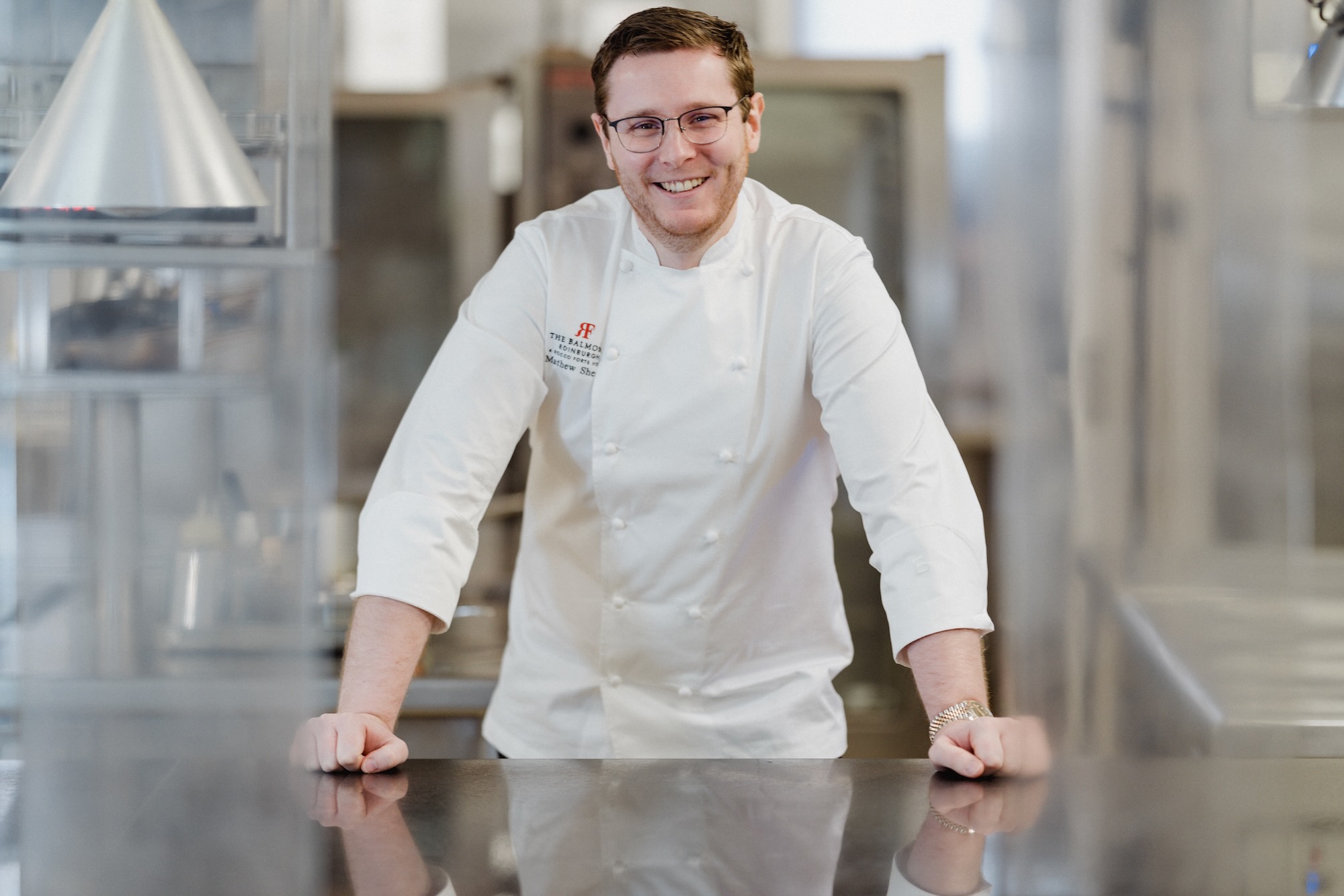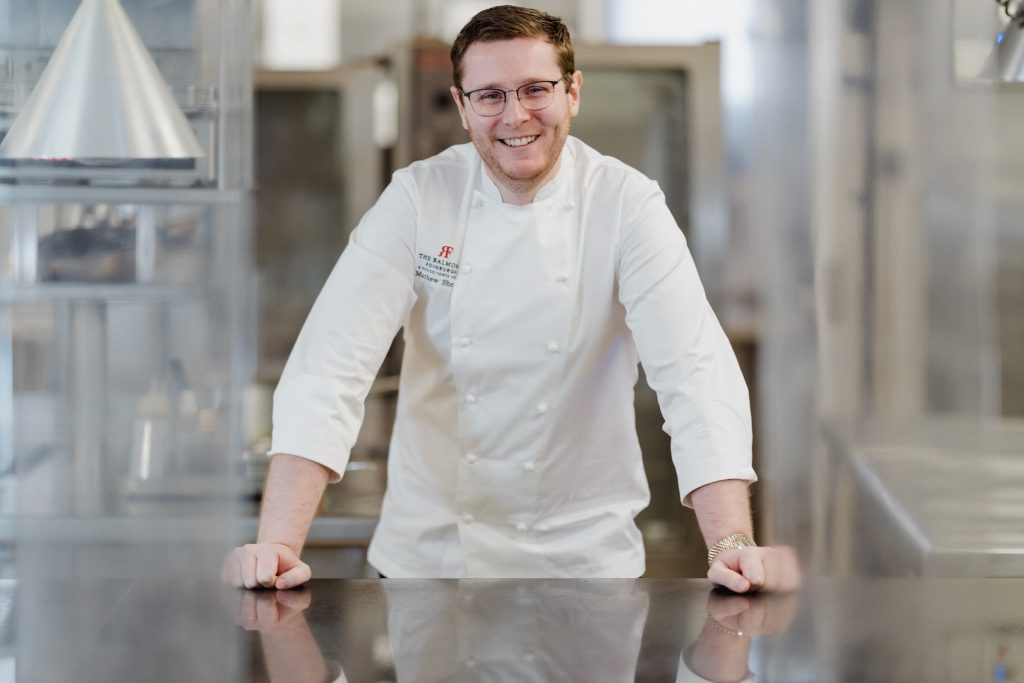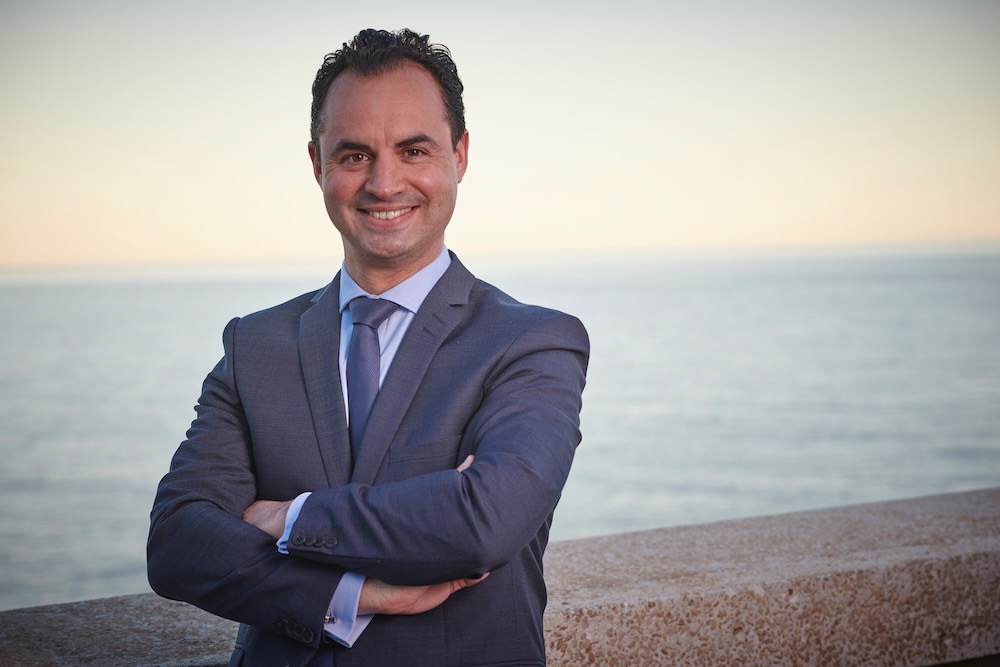With a decade of experience in Michelin-starred kitchens across the UK, Edinburgh-born Mathew Sherry returned to the capital in 2021 to take the helm as chef de cuisine at Number One at The Balmoral (read our review of The Balmoral here). Passionate about Scottish produce, Sherry has crafted a dining experience that celebrates the country’s finest ingredients while pushing the boundaries of modern gastronomy. Under his leadership, the restaurant has maintained its 4 AA Rosettes, earned a place on La Liste’s 1000 best restaurants in the world, and saw Sherry named The Catey’s Hotel Restaurant Chef of the Year in 2023. His approach is rooted in seasonality and collaboration with top Scottish and British suppliers, ensuring that every dish at Number One tells a story of provenance and innovation.
Please tell us what inspired you to become a chef and your career so far?
I never really wanted to do anything else. My grandmother was a fantastic home cook, and those early memories of being with her in the kitchen definitely sparked my interest.
Going out for dinner when I was young was always an occasion; there was always a reason to do it, it wasn’t something we just did casually. That special aspect of dining resonated with me and gave me a respect for restaurants from quite a young age.
I also just love eating!! I think it’s a great thing to be able to create something and make people happy through food. Cooking is something that is universal; you can make it as elaborate as you want, but at its core, it’s about feeding people. It’s satisfying to do that every day.
Describe a typical day for you – if such a thing exists!
I typically start work around 10 am. I’ll have breakfast, then head into the hotel and catch up with the executive chefs, Paul and Ross, to see if there’s anything interesting happening—any VIP guests or special requests we need to consider.
Then, I’m in the kitchen doing prep and setting up from about 10:30 am. The rest of the team comes in around noon. I like having an hour or two in the kitchen to myself in the morning to get organised so that when the team arrives, I can spend more time with them.
We have an exceptionally passionate team at Number One, so consistent hands-on training is really important to me. My senior sous-chef, John, and I try to provide as much guidance as possible to lead them in the right direction.
Afternoons are spent doing prep with the team, and then later in the day, I handle office work—placing orders, speaking with suppliers, checking produce availability, and monitoring weather conditions that might affect deliveries.
At 5:30 pm, we have a pre-service briefing with the kitchen and front-of-house teams, going over guest preferences, dietary requirements, special occasions, and anything else we need to tailor the dining experience.
Dinner service starts at 6 pm, so from there the busy kitchen starts.
Our schedule is fairly structured, we have a set framework for ordering and preparation. Every Thursday, we know we’ll receive a certain number of scallops, partridges, and crabs, for example. We rely on fresh produce, and certain ingredients like langoustines and scallops only arrive on specific days.
How has your previous restaurant experience shaped your approach at Number One?
I’ve been lucky to work in some amazing places—Castle Terrace, Northcote, and now here. Each one has had a different business model, despite all being at a very high standard.
Castle Terrace was focused on lunch and dinner. Northcote, being a hotel, had breakfast, afternoon tea, and banqueting to manage. At Number One, it’s primarily dinner service, which brings things full circle for me.
No matter where I’ve worked, my ethos has stayed the same: get the best produce possible, as locally as possible, and respect it. I try not to overcomplicate things; I want to showcase ingredients in their true form while using classic Scottish, British, and French techniques.
Please tell us what guests can expect when dining at Number One.
In a few words—amazing Scottish produce, cooked with respect and complemented by fantastic service.
We’re one of the few dining rooms in Edinburgh where you can have your table for the whole night and truly take your time to enjoy the experience, it’s quite special.
The service is relaxed while maintaining a level of formality. Our linen, tablecloths and silver cutlery give the restaurant a very special feel, it’s very accessible to all.
How do you balance traditional Scottish flavours with modern culinary techniques in your tasting menus?
We focus on respecting the core ingredient and elevating it using techniques that enhance its natural qualities.
Our approach is quite classical. We don’t use molecular gastronomy or overly modernist techniques. Instead, we apply modern methods where it makes sense while staying true to traditional fundamentals.
How do you create new dishes?
I always start with the most seasonal component first—whether it’s asparagus, scallops, or something else. The dish is built around that key ingredient, making sure it shines.
Most of our dishes—80-90%—start with the garnish, and then we decide what protein will complement it best.
Are there any particular achievements or moments in your career that you are especially proud of?
Being approached by The Balmoral to take over at Number One felt like a real achievement and a full-circle moment.
Any recognition is deeply appreciated. Whether it’s retaining four AA Rosettes or receiving awards like Chef of the Year, every accolade means something to me and the team. It motivates us to keep striving for more.
How do you envision the future of fine dining, especially in Edinburgh, and how do you see Number One within that landscape?
I think we’ll see more accessible fine dining—what some call ‘casual luxury.’
Younger diners might find traditional fine dining intimidating, so we’re seeing a shift towards high-end experiences that are more relaxed. That said, there will always be a place for the classic, formal style, which have the resources to create truly special dining experiences.
With rising costs, we’re also likely to see more secondary cuts of meat being used in creative ways to keep dishes refined yet cost-effective.
Are there any emerging culinary trends or ingredients that excite you and how might they influence your future menus?
I always look forward to spring produce—Scottish asparagus, tomatoes in the summer, and great vegetables in general.
I think we’ll likely see an increase in plant-based dishes, as well as a focus on using every part of an ingredient to minimise waste in the future.
What is your favourite Scottish ingredient to work with, and why?
Scottish fish and shellfish—especially scallops. West Coast scallops have an incredible texture and sweetness, and they’re so versatile.
What does luxury hospitality mean to you?
Anticipating a guest’s needs before they ask. Picking up on small details from conversations and using them to create a more personal and memorable experience.
Finally, what is your life motto? If you have one.
Something I always say to my team: “I’d rather be looking at it than looking for it.” In other words, always be prepared.




